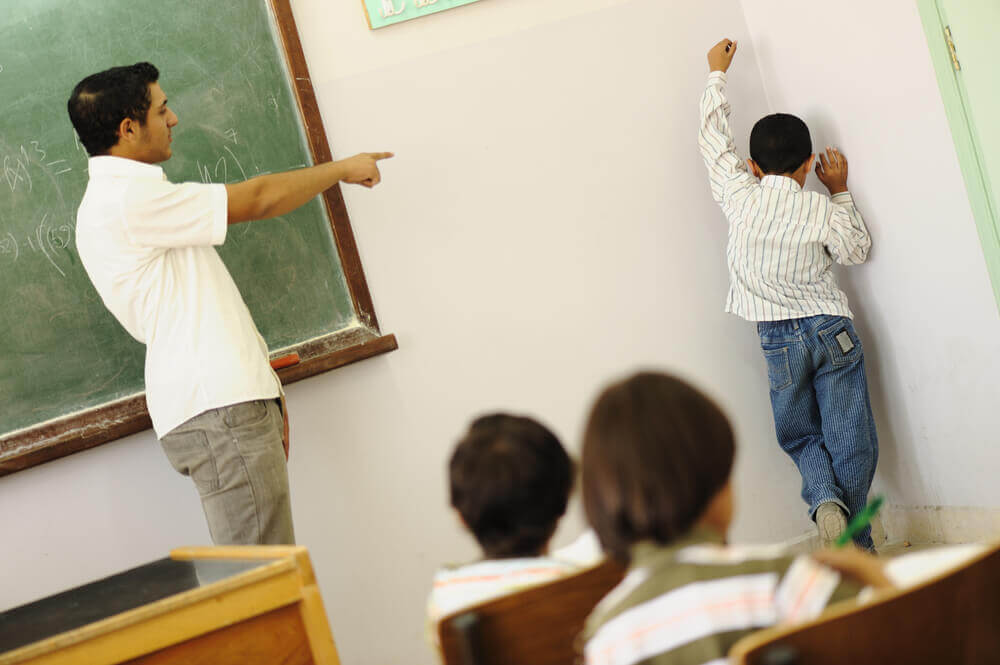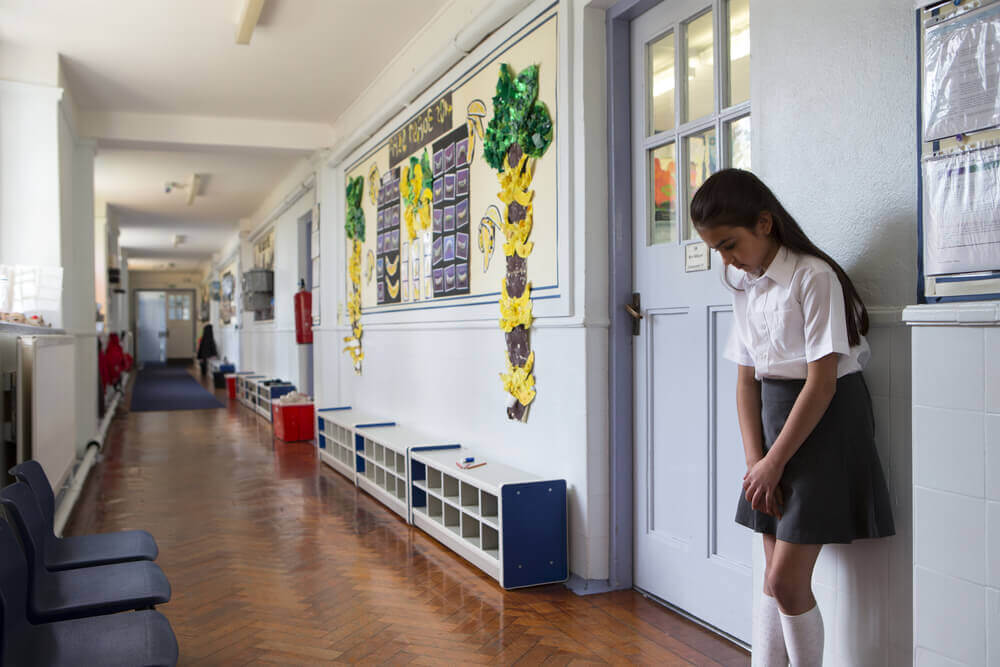Classroom Punishment and Management


Written and verified by the psychologist María Alejandra Castro Arbeláez
Classroom punishment is something that teacher training should take into account. In addition to knowledge of their subjects, teachers should also go into their classes with practical classroom management skills.
One of the most important parts of training future teachers is to teach them to lead a classroom. Many studies show that students learn better in attractive and orderly environments. However, all kids are different and thus, respond to classroom punishment differently.
What kind of unproductive behavior normally happens in the classroom?
We can group unproductive and bad behavior in students into the following categories:
- Low-level disruptions
- Disinterested students
- Aggressive and antisocial behaviors
Low-level disruptions and disinterested students are the most common behavior problems that teachers see in the classroom. In fact, teachers find it difficult to control them. Additionally, aggressive and antisocial behaviors are rare.
Common classroom punishment strategies
For many years, teachers have relied on two types of strategies. To fix unproductive behaviors, they use:
- Rewards, which promote good behavior
- Sanctions or classroom punishments, designed to discourage students from acting out in class.

Until relatively recently in the United States, teachers used corporal punishment in the classroom. In fact, this was only a few decades ago. After banning corporal punishment in education, teachers started using different classroom punishments.
These tiered approaches in the classroom are sets of consequences that increase in severity. Usually, teachers use them for all kinds of bad behavior.
- These tiered approaches usually start with a warning.
- Next, the student spends some time outside of class.
- Then, students go to the principal, administrator or dean.
- Finally, they may suspend or expel the student.
This approach makes sense because teachers can continue teaching. Then, other students can continue learning. However, it ignores the source of the problem.
“Problem” students find it difficult to learn after missing class. Additionally, they have a hard time moving on with material.
“The majority of teachers use this method. However, they say that these punishments are usually not effective.”
How can you stop bad behavior and avoid classroom punishments? Teachers say that the threats and actions that keep students from learning don’t always work. In addition, research supports this.
The evidence clearly shows that relying on these approaches, such as time out, doesn’t solve the problem. In fact, it may actually get worse over time.
Prevention is key to avoiding classroom punishment
The key is to focus on prevention. Taking into account the physical environment, curriculum, resources and teaching method, you can prevent students from disconnecting. Then, they won’t disrupt class.

“Teachers must teach children how to solve problems and conflicts. That way, students don’t resort to aggression to deal with situations.”
Therefore, teacher training should include learning techniques to create ordered and attractive classes. The most common problems in the classroom are disinterested and low-level disruptions. Therefore, it’s important to prevent these from happening.
Teachers should try to learn how to develop a teaching method that prevents these issues. All of this is better than trying to “fix” student behavior.
“Obviously, there will never be an approach that all teachers can use. Preventing and responding to student behavior depends on culture.”
Teacher training courses should teach approaches, skills and strategies to manage this behavior in an educational and supportive way. Teachers need to focus on strategies to prevent problems from happening.
Classroom punishment is something that teacher training should take into account. In addition to knowledge of their subjects, teachers should also go into their classes with practical classroom management skills.
One of the most important parts of training future teachers is to teach them to lead a classroom. Many studies show that students learn better in attractive and orderly environments. However, all kids are different and thus, respond to classroom punishment differently.
What kind of unproductive behavior normally happens in the classroom?
We can group unproductive and bad behavior in students into the following categories:
- Low-level disruptions
- Disinterested students
- Aggressive and antisocial behaviors
Low-level disruptions and disinterested students are the most common behavior problems that teachers see in the classroom. In fact, teachers find it difficult to control them. Additionally, aggressive and antisocial behaviors are rare.
Common classroom punishment strategies
For many years, teachers have relied on two types of strategies. To fix unproductive behaviors, they use:
- Rewards, which promote good behavior
- Sanctions or classroom punishments, designed to discourage students from acting out in class.

Until relatively recently in the United States, teachers used corporal punishment in the classroom. In fact, this was only a few decades ago. After banning corporal punishment in education, teachers started using different classroom punishments.
These tiered approaches in the classroom are sets of consequences that increase in severity. Usually, teachers use them for all kinds of bad behavior.
- These tiered approaches usually start with a warning.
- Next, the student spends some time outside of class.
- Then, students go to the principal, administrator or dean.
- Finally, they may suspend or expel the student.
This approach makes sense because teachers can continue teaching. Then, other students can continue learning. However, it ignores the source of the problem.
“Problem” students find it difficult to learn after missing class. Additionally, they have a hard time moving on with material.
“The majority of teachers use this method. However, they say that these punishments are usually not effective.”
How can you stop bad behavior and avoid classroom punishments? Teachers say that the threats and actions that keep students from learning don’t always work. In addition, research supports this.
The evidence clearly shows that relying on these approaches, such as time out, doesn’t solve the problem. In fact, it may actually get worse over time.
Prevention is key to avoiding classroom punishment
The key is to focus on prevention. Taking into account the physical environment, curriculum, resources and teaching method, you can prevent students from disconnecting. Then, they won’t disrupt class.

“Teachers must teach children how to solve problems and conflicts. That way, students don’t resort to aggression to deal with situations.”
Therefore, teacher training should include learning techniques to create ordered and attractive classes. The most common problems in the classroom are disinterested and low-level disruptions. Therefore, it’s important to prevent these from happening.
Teachers should try to learn how to develop a teaching method that prevents these issues. All of this is better than trying to “fix” student behavior.
“Obviously, there will never be an approach that all teachers can use. Preventing and responding to student behavior depends on culture.”
Teacher training courses should teach approaches, skills and strategies to manage this behavior in an educational and supportive way. Teachers need to focus on strategies to prevent problems from happening.
All cited sources were thoroughly reviewed by our team to ensure their quality, reliability, currency, and validity. The bibliography of this article was considered reliable and of academic or scientific accuracy.
- Carreño, A. M. P. (2010). Conductas disruptivas en el aula. González Serrano, Fernando. https://archivos.csif.es/archivos/andalucia/ensenanza/revistas/csicsif/revista/pdf/Numero_34/ANA_MARIA_PORCEL_1.pdf
- Espot, M. R., & Nubiola, J. (2015). La disciplina en el aula. Vanguardia Educativa, 35-39. http://www.mariarosaespot.es/pdfs/pdf_articulo_la_disciplina_en_el_aula_ve_19va._edicion__copia__copia.pdf
This text is provided for informational purposes only and does not replace consultation with a professional. If in doubt, consult your specialist.








